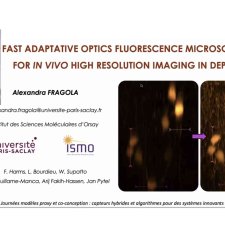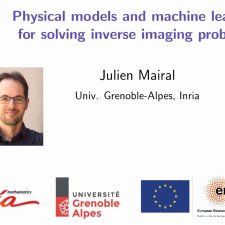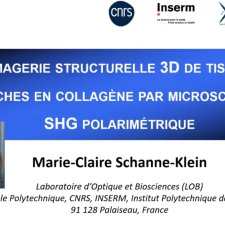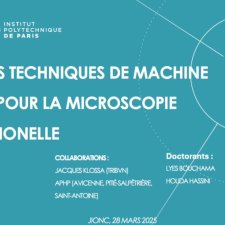Notice
Super-resolved fluorescence microscopy using random illuminations (RIM)
- document 1 document 2 document 3
- niveau 1 niveau 2 niveau 3
Descriptif
The resolution in optical microscopy is fundamentally constrained by the diffraction limit, which states that, whatever the interaction between the object and the incident light, the image (i.e. the intensity recorded by the camera) exhibits a frequency cut-off of 2/lambda where lambda is the wavelength of the radiated light. Super-resolved microscopy thus addresses the following issue : how can we form an image of the object with spatial frequencies greater than 2/lambda from low-resolution images that are frequency limited to 2/lambda. In this talk, we will present the basis of super-resolved microscopy using random illuminations (RIM). This technique consists in recording multiple low-resolution images of the sample under different speckled illuminations (obtained by passing the laser through a diffuser) and forming the super-resolved image from the variance of the speckled images using a variance matching algorithm. We will analyse the super-resolution capacity of such an approach and show its applicability to several imaging configurations (one or two-photon fluorescence microscopy, non-linear microscopy, surface imaging). In the second part of the talk, we will focus on fluorescence microscopy and discuss applications in the context of biological imaging. Biological structures such as embryos are three-dimensional objects, which pose new challenges for the microscopist. We will discuss our efforts to increase the speed of RIM imaging, improve sectioning, and reduce the light dose.
Intervention / Responsable scientifique
Sur le même thème
-
Fast adaptive optics fluorescence microscopy for in vivo high resolution imaging in depth
FragolaAlexandraThe study of fast biological phenomena at the cellular level has become possible even in depth in biological tissues in several animal models and rodents, thanks to efficient 3D microscopy techniques.
-
Physical Models and Machine Learning for Scientific Imaging
MairalJulienDeep learning has transformed image processing, often surpassing traditional methods that rely on precise modeling of optical image formation...
-
Imagerie structurelle 3D de tissus riches en collagène par microscopie SHG polarimétrique
Schanne-KleinMarie-ClaireLa microscopie par génération de seconde harmonique (SHG) permet d’imager le collagène.…
-
Impact des techniques neuronales pour la microscopie computationnelle
DorizziBernadetteGottesmanYaneckCet exposé s'attachera à décrire l'intérêt des techniques de réseaux de neurones pour la microscopie computationnelle…




